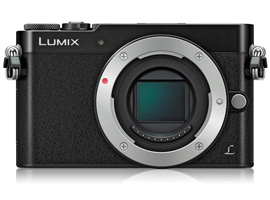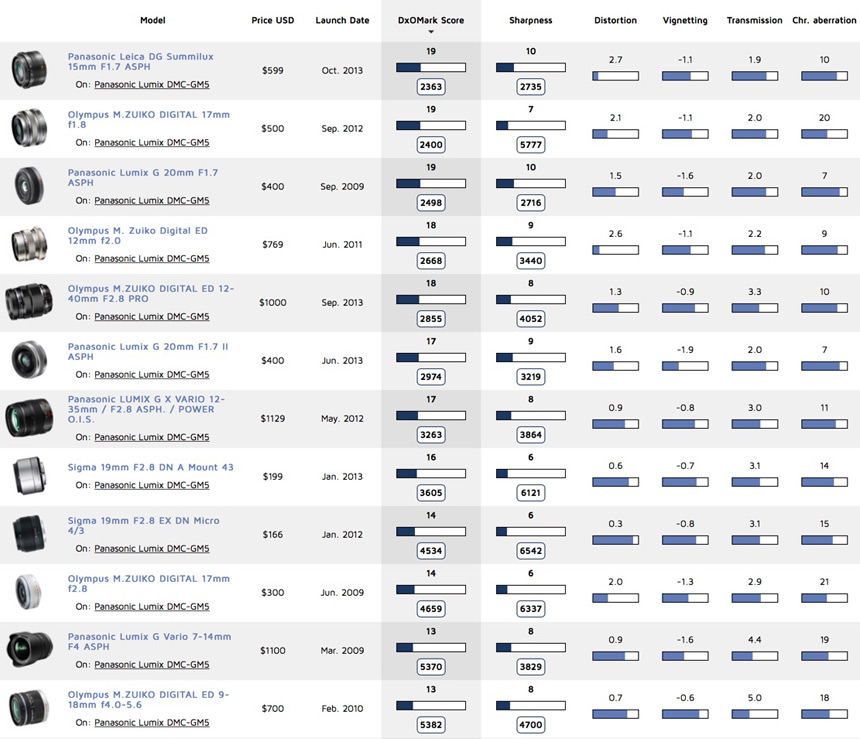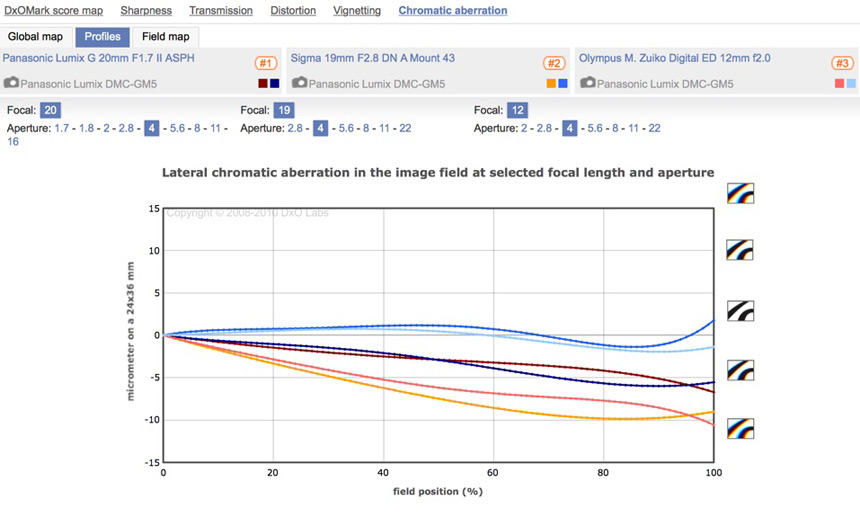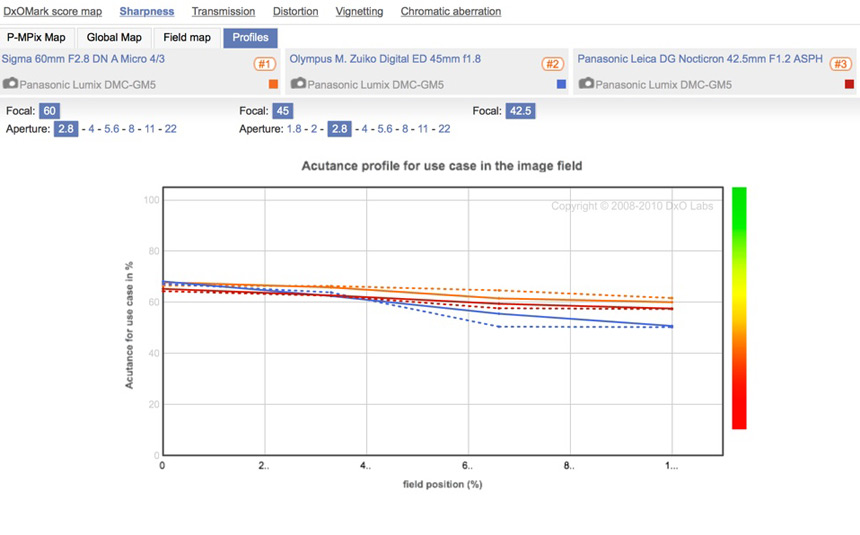Introduction
Specifications and Features
Following the GM1 (the first of a new generation of truly miniature camera models with interchangeable lenses based on the Micro-Four-Thirds format), the GM5 (there were no other models in between) offers a similar 16-MPix Live MOS sensor in a body that’s a little larger and perhaps more convenient with a 1,166k-dot electronic viewfinder complete with proximity sensor. At $899, including the 12-32mm lens, the GM5 measures a little more than the original at just 3.9 x 2.3 x 1.4″ (98.5 x 59.5 x 36.1mm), and weighs 6.35 oz (180g) — body-only, complete with battery and SD card.
Some of the more significant changes over the GM1 include as options a hotshoe and small bundled flash (instead of small built-in unit), and at the rear, a new command-style dial, direct access to ISO on a four-way d-pad, two customizable buttons, and a fixed 3.0”-wide 16:9 ratio screen TFT LCD with slightly lower resolution (921k-dot, down from 1.03M-dot). The GM5 also has slightly faster continuous shooting of up to 5.8 fps, but common to both are 40 fps at full-resolution using an electronic shutter option (with up to 1/16,000 sec shutter speed option), and sensitivity up to ISO 25,600.
Although the GM5 lacks built-in stabilization, relying instead on in-lens-based options, including the two miniature lens models intended specifically for (although not limited exclusively to) the camera, the 12-32 f3.5-5.6 and 35-100mm f3.5-5.6 lenses, it has some advanced video features for such a diminutive model. These include Full HD up to 60fps (instead of 30fps for the GM1), as well as a 24fps option in AVCHD and MP4 with stereo sound and focus peaking, the latter an option available when remotely viewing using the optional app and built-in Wi-Fi function.
One the main benefits of the GM5 is its access to a very wide range of high-quality lenses from Panasonic and Olympus which both utilize the same Micro-Four-Thirds mount. And there are several lenses from third parties as well. We’ve not yet had the opportunity to test all of those available with the GM5, including some major models (so please don’t be disappointed if your favorite lens isn’t included), however, it’s still an extensive resource that we hope you’ll be able to take advantage of.
Best wide-angle primes and zooms
Admittedly the above list shows only the top 12 models, and we’ve yet to test the $655 Panasonic 8mm f3.5 Fisheye and the equivalent (albeit not yet available) $1000 Olympus MZ Digital ED 8mm f1.8 Fisheye and the incredible 7-14mm f2.8 Pro at $1,300, but our data in this category is pretty extensive.
The best-performing models in this group are, perhaps unsurprisingly, close in focal length to “normal” or standard lenses. Three models vie for the top slot with a DxOMark lens score of 19 points, while the fourth, fifth, and sixth follow narrowly behind, making any of these models a solid choice.
As premium models go, the Olympus M. Zuiko Digital 17mm f1.8 and to a lesser extent the 12mm f2.0 (which stands out as the widest model and therefore is the most challenging optically in the top four) have quite high levels of CA (measured in microns) on sensors like this with small sensels (or pixel sites), which is why it can be confusing to compare lenses across different sensor sizes and formats.
Cameras such as the Panasonic Lumix DMC-GM5 utilize in-camera correction of various aberrations, even on the fly, though it’s important to bear in mind that these corrections may not be completely effective. Our measurements disregard in-camera aberration corrections so that lenses can be compared, regardless of the camera body attached.
The original Panasonic Lumix G 20mm f1.7 ASPH was highly regarded, and the replacement performs almost identically, with high levels of sharpness and relatively low CA. Sigma’s update to the 19mm f2.8 is another that stands out for its high image quality and accessible pricing. At just $199, it’s a steal. If money is no object, the Olympus ED 12-40mm f2.8 Pro is an outstanding performer, but it’s quite a large and heavy lens when compared with the primes. Equally outstanding is the equivalent (12-35mm f2.8) model from Panasonic, but at $1130 it’s even less accessible.
Either of the two ultra-wide zooms in this category could be chosen for their image quality, though the nicely-made Panasonic 7-14mm (14-28mm equivalent) has a wider field of view than the more compact Olympus ED 9-18mm f4-5.6, and has higher peak sharpness. However at $1100, it’s the least accessibly-priced in the group.
Best standard and telephoto primes and zooms
Excluding the Olympus 75mm f1.8 that we’ve yet to test on the GM5, the 12 top-performing standard and telephoto lenses vary considerably in price and scope. The Sigma 60mm and 30mm f2.8 models stand out for their balance of competitive image quality and accessible pricing. If budget is a concern, then look no further for short telephotos.
Of course the maximum aperture isn’t as attractive as the pricey Panasonic Leica Nocticron 42.5mm (85mm equivalent) f1.2 ASPH in first place, nor the Olympus 45mm f1.8, nor the Panasonic Leica Summilux 25mm f1.4 in joint second place, but then again, the Sigma 30mm isn’t far behind optically and the slightly longer 60mm is on par anyway.
If those focal lengths and maximum apertures are just too much of a compromise, the 45mm f1.8 from Olympus is attractively priced at $389. It doesn’t have the same level of build quality nor sharpness as the $1600 Nocticron, particularly at wider apertures, but the small size and low weight, not to mention the difference in price, means it’s far more practical for everyday use. Although the 45mm has very good close focus abilities, the Olympus 60mm f2.8 Macro in fourth place is another excellent performer. In addition to weather sealing, it’s a true macro lens with 1x (1:1) maximum magnification. Optically, it’s a terrific performer and has relatively low levels of chromatic aberration, a shortcoming that’s always troublesome with macro lenses.
Unlike the more mature DSLR lens lineups, long telephoto primes are nonexistent in mirrorless systems; however, there are some good telephoto zoom models available. Although there some new models that we’ve yet to test (such as the highly promising fast-aperture Olympus 40-150mm f2.8), the best-performing model we’ve seen so far is the stabilized Panasonic 35-100mm (70-200mm equivalent) f2.8. And although it compares with some primes in optical quality (mostly at the short end of the zoom range), the tiny Olympus 40-150mm f4-5.6 isn’t a bad performer, and at $236, it is rather more in keeping with the more modest dimensions of the Lumix GM5.
Accounting for its high ranking, the Sigma performs exceptionally well from the initial aperture. The Olympus is good centrally, but significantly less so in the outer field, though that’s likely to be less of a concern in a portrait lens like this.










DXOMARK encourages its readers to share comments on the articles. To read or post comments, Disqus cookies are required. Change your Cookies Preferences and read more about our Comment Policy.